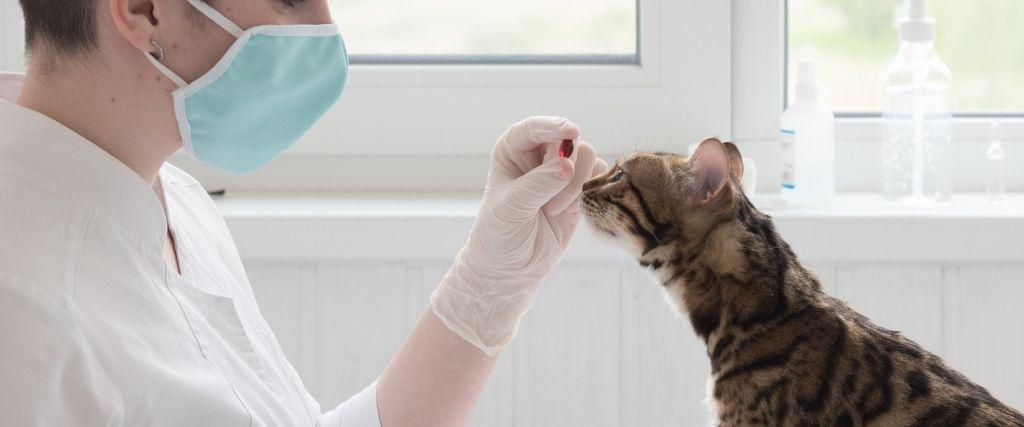November is National Diabetes Month and, although this originally began as an awareness day for humans who are stricken with this endocrine disease, it has evolved into National Pet Diabetes Month as well. As veterinarians, we’re all for more awareness about this disease, as many people don’t realize how prevalent it is. In fact, 1 in every 200 cats will get it in their lifetime! And because it’s somewhat preventable in some pets, we decided to take you through some important facts about pet diabetes, including its commonality, prognoses, and the most common symptoms to alert you to take your beloved dog or cat to see a veterinarian right away.
Prevalence of Pet Diabetes
How common is diabetes in pets?
In dogs, the prevalence is about 1 in 500 dogs. The common age of diagnosis 7-9 yrs old with female dogs 3 times more likely than males. Dogs are more likely to have insulin-dependent diabetes, similar to Type I in humans.
In cats, as mentioned, the prevalence is about 1 in 200 cats. The common age of diagnosis 10-13 yrs old with male cats more than twice as likely as females. Cats are more likely to get non-insulin-dependent diabetes, similar to Type II in humans. This does NOT necessarily mean cats don't require insulin.

Is Your Pet at Risk?
What can cause diabetes?
First, diabetes is the absolute or relative deficiency of insulin. Insulin is a hormone produced by beta cells in the pancreas and is necessary to carry glucose from the blood into tissues for use. Certain hormones, like cortisol, and excess adipocytes (fat cells) can reduce the sensitivity of tissues to insulin, requiring more insulin to do the same job. With "less" insulin, the glucose in the blood increases, and tissues cannot get glucose for energy.
What causes diabetes in cats?
The most common risk factor of diabetes in cats is obesity, making obese cats nearly 4x more likely to get diabetes with male cats at higher risk than females. Other causes include chronic pancreatitis or other less common hormonal conditions (Cushing's disease, acromegaly). Some breeds appear predisposed including Burmese, Tonkinese, and Norwegian Forest cats. Most of the diabetic cats we see are overweight male Domestic Shorthair cats, 10 years old or more.
What causes diabetes in dogs?
Diabetes in dogs is thought to be an immune-mediated process that leads to the destruction of important cells in the pancreas that secrete insulin. The destruction of these cells leads to absolute insulin deficiency.
Other risk factors include obesity - especially fatty foods/treats leading to concurrent pancreatitis. Conditions contributing to higher hormone levels (cortisol, growth hormone, progesterone) play a role, as well as genetics with some higher risks in certain breeds (Yorkshire Terriers, Poodles, Miniature Schnauzers, Pugs, Bichon Frises, and Labrador Retrievers to name a few).
Do pets that are not overweight get diabetes?
Overweight pets are the highest risk group I see in practice. However, conditions like pancreatitis (typically from feeding high fat or rich foods) can damage insulin-producing cells in the pancreas, sometimes permanently. In dogs, genetics can predispose and have an immune-mediated component that we cannot necessarily control.
Can I Prevent My Pet From Getting Diabetes?
Keeping your pet at a lean body condition with adequate daily activity, avoiding high fat treats or foods, and regular checkups with your vet including physical exams with blood and urine screening tests annually are the best ways you can keep your pet healthy and reduce the risk.

Diagnosing Diabetes
What is a sign my pet has diabetes?
Signs that your cat or dog may have diabetes are as follows:
- Excessive thirst
- Excessive urination
- Ravenous appetite with weight loss
How Does a Veterinarian Diagnose Diabetes?
Your vet will likely perform blood and urine testing to look for elevated glucose levels in the blood urine. Sometimes, additional tests are indicated for confirmation or screening for concurrent diseases that can have similar signs and/or may contribute to the development of diabetes.
What Are the Different Types of Diabetes, And What Are the Treatments?
Basically, there is insulin-dependent diabetes (similar to Type I in humans) - most common in our dogs, non-insulin-dependent diabetes (similar to Type II in humans) - most common in our cats, and Type III diabetes related to high concentrations of hormones contributing to insulin resistance - reported in both dogs and cats.
In dogs, a diet change to a low fat, high complex carbohydrate diet along with long-acting insulin is typically utilized for management.
Although cats often get a non-insulin-dependent form of diabetes, they often still require insulin for management. You should change your cat’s diet to a low carbohydrate, high protein, preferably canned diet and work towards better weight management.
If Left Untreated, What Will Happen to My Pet With Diabetes?
Because glucose is needed in the tissues and organs for normal functions, the body will start to break down fats for this purpose. That sounds like it would be a good thing, but in fact, the breakdown of fats results in ketones that are less efficient energy producers and the body struggles to clear them. Over time, ketones then build up in the system and make the pet extremely ill - vomiting, not eating, dehydration, extreme lethargy, and cats can develop a severe liver condition called hepatic lipidosis (fatty liver). This condition is termed diabetic ketoacidosis (DKA). If left untreated, the pet can die.
Do I Need to Be Aware of Other Health Conditions Caused by Diabetes?
Typically, we will see cataract formation, especially in dogs. This can ultimately cause vision impairment. There can be an increased risk for urinary tract infections and delayed healing can be a result of diabetes as well. Neuropathies with weakness in the hind legs, particularly in unregulated cats can occur.
Although not caused by diabetes, other health conditions can impact how well we can manage diabetes. For example, dental disease, specifically periodontal disease, can significantly increase the amount of insulin needed for regulation as well as contribute to other potential health issues that can complicate regulation and overall health.
Your Pet Can Still Live a Full Life with Diabetes
Does having diabetes hurt my pet?
Uncontrolled diabetes can make pets feel very lethargic and not themselves. Managing diabetes can be very challenging for all involved. However, well-managed pets can have a great quality of life.
What Will My Daily Routine Be Like If My Pet Has Diabetes?
Typically, changing your pet’s diet is the best way to control diabetes. In dogs, studies show a diet high in complex carbohydrates, high in fiber, and low in fat is best. Measured morning and evening meals 12 hours apart are best. You’ll likely be giving your dog insulin injections just under the skin consistently every 12 hours using a tiny needle at mealtimes. Adequate exercise/walks twice a day is key! Consistency with your dog's diet and exercise is important. Try to limit snacks, if you give them at all, to a low-fat, low-calorie treat to be given at the same time daily for consistency.

In cats, studies show that they do best with a low carbohydrate, low fiber, high protein canned food. Cats typically are grazers, doing best with several small meals throughout the day. Measured meals 2-4 times a day are best, but consistency is important. Insulin injections are often required and given just under the skin typically every 12 hours using a tiny needle. Regular playtime with wand toys, laser pointers, or whatever your cat's favorite toy helps to provide daily exercise.
Monitoring blood glucose levels is important for diabetes regulation. You can use at-home monitors, as recent ones have new sensors that measure glucose without the use of needles.
Evaluate your pet daily for any changes in water intake, urine output, energy level, or change in appetite, as these are important parameters for evaluating diabetes regulation.
How Long Do Dogs and Cats Live After Being Diagnosed With Diabetes?
Studies for dogs vary from 18 months to 2 years on average. Well-managed patients have a good quality of life for longer, but several factors are at play. There can be concurrent disease conditions or complications that can impact life quality.
Diabetes is an intensive condition to manage, requiring daily medicating and financial dedication that can be stressful for families.
Studies vary in cats, with many living about 1.5 years but 25% managing to live over 4 years. Diabetic cats are different from dogs in that some cats (50% in one study) can go into remission. This means that their blood glucose returns to normal, no longer requiring insulin. This state is often temporary, but some feline patients go into remission indefinitely. This most often occurs when diabetes is diagnosed early and treated immediately.
If you suspect your pet has diabetes, time is of the essence. We know that getting a diabetes diagnosis for your dog or cat can be devastating, but we are here to help. Give us a call or schedule your pet's appointment here.
The Drake Center for Veterinary Care is an AAHA-accredited animal hospital located in Encinitas, CA. The Drake Center loves being a source of information for all pet owners across the country however if you have any questions regarding pet care and do not live in Encinitas, CA or surrounding cities, we encourage you to contact your local veterinarian.

